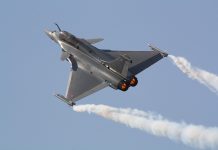
Russian Deputy Security Council Chairman Dmitry Medvedev has issued a stern warning to the West, cautioning against any efforts to reintroduce nuclear weapons to Ukraine, which were transferred to Russia following the Soviet Union’s collapse. Medvedev outlined the potential consequences of such actions, suggesting that they could provoke Russia to escalate its nuclear capabilities. In response, he emphasized that Moscow would be compelled to share its advanced nuclear technologies with its allies, noting that discussions were ongoing regarding which of America’s adversaries might be suitable recipients.
Medvedev’s statements also highlighted the potential fallout from returning nuclear weapons to Ukraine. He proposed that the best course of action for the West would be to halt military support for Kyiv entirely. Pointing to the recent demonstration of Russia’s “Oreshnik” hypersonic missile, which struck Dnipro, he underscored the growing sophistication of Russia’s arsenal, particularly its nuclear-capable weapons, which could be deployed with devastating speed. Medvedev stressed that European defenses would be unable to counter such advanced weaponry, especially if armed with nuclear warheads, and suggested that any early warning would provide minimal protection to civilians.
The warning comes amid increasing concerns over Russia’s expanding military cooperation with countries such as North Korea, Iran, and China. U.S. officials have noted that Russia is supplying North Korea with artillery shells, military equipment, and troops to support its war efforts in Ukraine, while hoping to receive long-range nuclear missile technologies in exchange. Medvedev’s rhetoric echoed statements by Russian President Vladimir Putin, who reaffirmed Russia’s readiness to provide long-range weapons to adversaries capable of striking NATO member states or their allies in retaliation for their support of Ukraine.
As the conflict continues, both Russia and NATO are bracing for further escalation. Meanwhile, U.S. and European officials have discussed the possibility of aiding Ukraine in regaining control over its nuclear arsenal, a sensitive issue tied to the 1994 Budapest Memorandum, where Ukraine agreed to relinquish its nuclear weapons in exchange for security assurances. The potential restoration of Ukraine’s nuclear capabilities remains a deeply controversial topic, adding further complexity to an already volatile geopolitical landscape.
On November 21, Russia conducted a large-scale missile strike on Ukrainian territory, which it later revealed to be a test of its new medium-range ballistic missile system, the “Oreshnik.” This missile, capable of carrying multiple warheads, further enhances Russia’s strategic capabilities. Putin framed the attack as retaliation for Ukrainian military strikes on Russian regions such as Bryansk and Kursk, which were carried out using Western-supplied weaponry, including the American-made ATACMS and the French-British Storm Shadow missile systems.
In response to Russia’s growing missile threat, Ukrainian President Volodymyr Zelensky has called for a decisive international response, urging global leaders to confront Russia’s aggression. Ukraine has also entered discussions with the U.S. for more advanced missile defense systems, including the Patriot missile defense system and the Aegis combat system. Additionally, the THAAD (Terminal High Altitude Area Defense) system is being considered, though concerns over the feasibility of its transfer to Ukraine persist due to its high cost and the extensive training required for its effective use.
Despite the potential advantages of acquiring such advanced systems, experts caution that the U.S. may be reluctant to provide Ukraine with the THAAD system due to the significant financial burden and the risks associated with deploying such systems in a conflict zone. Ivan Stupak, a military analyst from the Ukrainian Institute of the Future, argued that the system’s $3 billion price tag, coupled with the $20 million cost per missile interception, makes it a challenging option. The potential for these systems to be damaged or destroyed, as seen with previous U.S. weapon systems like the Patriot, further complicates the decision.
The U.S. faces a difficult strategic calculus, weighing the potential benefits of enhancing Ukraine’s missile defense against the risks of escalating the conflict and the financial implications of maintaining such systems. The future of missile defense in Ukraine will depend not only on the willingness of the U.S. to provide advanced technologies but also on the strategic priorities of Western allies and the broader international community. As the situation continues to evolve, decisions made in the coming months will play a critical role in shaping the trajectory of the conflict and the global security environment.





